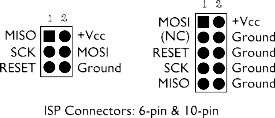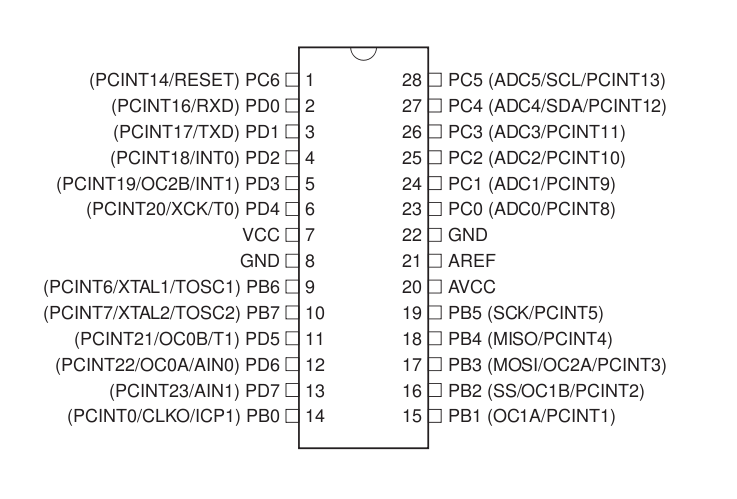AVR Microcontroller Class 2009
From HacDC Wiki
Syllabus, course material, homeworks, photos, etc from an Introduction to Microcontrollers with AVR chips class can be found here.
Also see (and contribute to) Useful AVR Links
Class 0: Introduction and Setup
What the AVRs are, what all the pins do, what they can do for you. Then the toolchain: soldering together the programmer kits, getting the software up and running.
Labs: building the kit and running a test LED flasher. (Almost all lab today, little talk.)
Resources:
- Slides from class: Media:class0.pdf
- ATmega48P Datasheets (get both): ATmega48P Summary Datasheet and The Long ATmega48P Datasheet
- Download the software part of the toolchain: For Mac folks: AVR Mac Pack. For Windows folks: WinAVR. For Ubuntu linux folks: "sudo apt-get install build-essential avr-libc binutils-avr gcc-avr avrdude"
- Programmer and mega48 pinouts:


Class 1: Outputs and Bit Math
How to make chips speak to the outside world, pin-by-pin. Enough C programming fundamentals to make it work. Pulse-width modulation.
Labs: Cylon eyes and dimming LED's. Extra credit: cross-fading cylon eyes!
Class 2: Inputs: Buttons and Analog-to-Digital conversion (ADC)
Gather data from the world.
Labs: pushbutton organ, light-dependent theremin. Extra credit: something else!
Class 3: Interrupts and Timers
Interrupts call subroutines when certain conditions are true. Timers let you time stuff. Together, they take a lot of the programming burden off your shoulders, and enable really cool stuff.
Labs: Driving servo motors and/or build a better audio synth, use an LED as a light-source and light-sensor. Extra credit: capacitive touch-switch!
Class 4: Serial I/O
Make the micro speak to your computer (and vice-versa). We can also cover other serial protocols (I2C, SPI).
Labs: Basic serial in/out, data-logging light sensor. Maybe SD/MMC cards? Extra credit: ADC + serial output + Python + laptop = ghetto oscilloscope.
Class 5: EEPROM, PROGMEM, etc
Tying up loose ends, special requests. PROGMEM lets you use the program memory to store lots of (constant) data. EEPROM is like flash -- there's not much of it, but it stays when you power off. Can also do misc topic requests here.
Labs: writing out really long strings to serial, saving last known states for battery failure. Maybe I can think up something sexy to use these methods. Maybe not.
